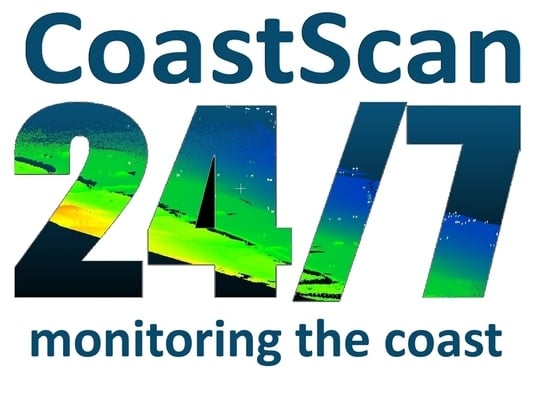Cross-Shore Intertidal Bar Behavior along the Dutch Coast: Laser Measurements and Conceptual Model
Abstract
1. Introduction
2. Field Site Kijkduin
2.1. Field Site
2.2. Laser Scans of Intertidal Topography
2.3. Wind and Water Data
3. Results
3.1. Intertidal Bar Cycle
3.2. Detailed Intertidal Bar Behavior
3.2.1. Period A: Initial Bar Development (M1)
3.2.2. Period B: Onshore Bar Migration (M2)
3.2.3. Period C: Horizontal and Vertical Growth (M3)
3.2.4. Period D: Shoreward Movement and Bar Destruction (M4 and M5)
4. Conceptual Intertidal Bar Behavior Model
5. Discussion
6. Conclusions
Author Contributions
Funding
Acknowledgments
Conflicts of Interest
References
- Masselink, G.; Kroon, A.; Davidson-Arnott, R. Morphodynamics of intertidal bars in wave-dominated coastal settings—A review. Geomorphology 2006, 73, 33–49. [Google Scholar] [CrossRef]
- Phillips, M.S.; Blenkinsopp, C.E.; Splinter, K.; Harley, M.D.; Turner, I.L. Modes of Berm and Beachface Recovery Following Storm Reset: Observations Using a Continuously Scanning Lidar. J. Geophys. Res. Earth Surf. 2019, 124, 720–736. [Google Scholar] [CrossRef]
- Brooks, S.M.; Spencer, T.; Christie, E. Storm Impacts and Shoreline Recovery: Mechanisms and Controls in the Southern North Sea. Geomorphology 2017, 283, 48–60. [Google Scholar] [CrossRef]
- Splinter, K.; Strauss, D.; Tomlinson, R.B. Assessment of post-storm recovery of beaches using video imaging techniques; A case study at Gold coast, Australia. IEEE Trans. Geosci. Remote. Sens. 2011, 49, 4704–4716. [Google Scholar] [CrossRef]
- Biausque, M.; Grottoli, E.; Jackson, D.; Cooper, J. Multiple intertidal bars on beaches: A review. Earth Sci. Rev. 2020, 210, 18. [Google Scholar] [CrossRef]
- Houser, C.; Greenwood, B. Response of a swash bar to a sequence of storms. In Proceedings of the International Conference on Coastal Sediments 2003, Sheraton Sand Key Resort, Clearwater Beach, FL, USA, 18–23 May 2003. [Google Scholar]
- Kroon, A.; Masselink, G. Morphodynamics of intertidal bar morphology on a macrotidal beach under low-energy wave conditions, North Lincolnshire, England. Mar. Geol. 2002, 190, 591–608. [Google Scholar] [CrossRef]
- Robin, N.; Levoy, F.; Monfort, O. Short term morphodynamics of an intertidal bar on megatidal ebb delta. Mar. Geol. 2009, 260, 102–120. [Google Scholar] [CrossRef]
- Phillips, M.S.; Harley, M.D.; Turner, I.L.; Splinter, K.D.; Cox, R.J. Shoreline Recovery on Wave-Dominated Sandy Coastlines: The Role of Sandbar Morphodynamics and Nearshore Wave Paramm. Mar. Geol. 2017, 385, 146–159. [Google Scholar] [CrossRef]
- Cohn, N.; Anderson, D.L.; Susa, T.; Ruggiero, P.; Honegger, D.; Haller, M.C. Observations of Intertidal Bars Welding to the Shoreline: Examining the Mechanisms of Onshore Sediment Transport and Beach Recovery. In Proceedings of the American Geophysical Union, Fall Meeting 2014, San Francisco, CA, USA, 15–19 December 2014. Abstracts 31, EP31B-3552. [Google Scholar]
- Reniers, A.J.H.M.; Gallagher, E.L.; MacMahan, J.H.; Brown, J.A.; Van Rooijen, A.A.; Vries, J.S.M.V.T.D.; Van Prooijen, B.C. Observations and modeling of steep-beach grain-size variablity. J. Geophys. Res. Oceans 2013, 118, 577–591. [Google Scholar] [CrossRef]
- Hoonhout, B.M.; De Vries, S. Field measurements on spatial variations in aeolian sediment availability at the Sand Motor mega nourishment. Aeolian Res. 2017, 24, 93–104. [Google Scholar] [CrossRef]
- Cowell, P.J.; Stive, M.J.; Niedoroda, A.W.; de Vriend, H.J.; Swift, D.J.; Kaminsky, G.M.; Capobianco, M. The coastal-tract (part 1): A conceptual approach to aggregated modeling of low-order coastal change. J. Coast. Res. 2003, 19, 812–827. [Google Scholar]
- Wijnberg, K.M.; Kroon, A. Barred beaches. Geomorphology 2002, 48, 103–120. [Google Scholar] [CrossRef]
- Luijendijk, A.P.; Ranasinghe, R.; De Schipper, M.A.; Huisman, B.A.; Swinkels, C.M.; Walstra, D.J.; Stive, M.J. The initial morphological response of the Sand Engine: A process-based modelling study. Coast. Eng. 2017, 119, 1–14. [Google Scholar] [CrossRef]
- Van Houwelingen, S. Spatial and Temporal Variability in Ridge and Runnel Morphology along North Lincolnshire Coast, England. Ph.D. Thesis, Loughborough University, Loughborough, UK, 2005. [Google Scholar]
- Sallenger, A.H., Jr.; Krabill, W.B.; Swift, R.N.; Brock, J.; List, J.; Hansen, M.; Holman, R.A.; Manizade, S.; Sontag, J.; Meredith, A.; et al. Evaluation of airborne topographic lidar for quantifying beach changes. J. Coast. Res. 2003, 19, 125–133. [Google Scholar]
- Blenkinsopp, C.; Mole, M.; Turner, I.L.; Peirson, W.L. Measurements of the time-varying free-surface profile across the swash zone obtained using an industrial LIDAR. Coast. Eng. 2010, 57, 1059–1065. [Google Scholar] [CrossRef]
- Harley, M.; Turner, I.; Short, A.D.; Ranasinghe, R. Monitoring Beach Processes Using Conventional, Rtk-GPS and Image-Derived Survey Methods: Narrabeen Beach, Australia. In GIS for the Coastal Zone: A Selection of Papers from CoastGIS 2006; Australian National Centre for Ocean Resources & Security: Wollongong, Australia, 2007; pp. 151–164. [Google Scholar]
- Masselink, G.; Austin, M.; Tinker, J.; O’Hare, T.; Russell, P. Cross-shore sediment transport and morphological response on a macrotidal beach with intertidal bar morphology, Truc Vert, France. Mar. Geol. 2008, 251, 141–155. [Google Scholar] [CrossRef]
- Turner, I.L.; Russell, P.E.; Butt, T. Measurement of wave-by-wave bed-levels in the swashzone. Coast. Eng. 2008, 55, 1237–1242. [Google Scholar] [CrossRef]
- Masselink, G.; Russell, P.; Turner, I.L.; Blenkinsopp, C. Net sediment transport and morphological change in the swash zone of a high-energy sandy beach from swash event to tidal cycle time scales. Mar. Geol. 2009, 267, 18–35. [Google Scholar] [CrossRef]
- Quartel, S.; Ruessink, B.G.; Kroon, A. Daily to seasonal cross-shore behavior of quasi-persistent intertidal beach morphology. Earth Surf. Process. Landforms 2007, 32, 1293–1307. [Google Scholar] [CrossRef]
- Uunk, L.; Wijnberg, K.; Morelissen, R. Automated Mapping of the Intertidal Beach Bathymetry from Video Images. Coast. Eng. 2010, 57, 461–469. [Google Scholar] [CrossRef]
- Hughes, M.G.; Masselink, G.; Brander, R.W. Flow velocity and sediment transport in the swash zone of a steep beach. Mar. Geol. 1997, 138, 91–103. [Google Scholar] [CrossRef]
- Aarninkhof, S.G.; Turner, I.L.; Dronkers, T.D.; Caljouw, M.; Nipius, L. A video-based technique for mapping intertidal beach bathymetry. Coast. Eng. 2003, 49, 275–289. [Google Scholar] [CrossRef]
- O’Dea, A.; Brodie, K.L. Spectral analysis of beach cusp evolution using 3D lidar scans. In Proceedings of the 9th International Conference on Coastal Sediments 2019 (CS19), Tampa/St. Petersburg, FL, USA, 27–31 May 2019; pp. 657–673. [Google Scholar]
- Vos, S.E.; Lindenbergh, R.; de Vries, S. Coastscan: Continuous monitoring of coastal change using terrestrial laser scanning. In Proceedings of the 8th International Conference on Coastal Dynamics, Helsingør, Denmark, 12–16 June 2017. [Google Scholar]
- O’Dea, A.; Brodie, K.L.; Hartzell, P. Continuous Coastal Monitoring with an Automated Terrestrial Lidar Scanner. J. Mar. Sci. Eng. 2019, 7, 37. [Google Scholar] [CrossRef]
- Vos, S.E.; Hobbelen, R.N.P.; Spaans, L.; de Vries, S.; Lindenbergh, R.C. Cross-shore sand patterns in the intertidal zone: A case study with permanent laser scanning at Kijkduin beach. In Proceedings of the 9th International Conference on Coastal Sediments 2019 (CS19), Tampa/St. Petersburg, FL, USA, 27–31 May 2019; pp. 2657–2668. [Google Scholar]
- Brand, E.; De Sloover, L.; De Wulf, A.; Montreuil, A.-L.; Vos, S.E.; Chen, M. Cross-Shore Suspended Sediment Transport in Relation to Topographic Changes in the Intertidal Zone of a Macro-Tidal Beach (Mariakerke, Belgium). J. Mar. Sci. Eng. 2019, 7, 172. [Google Scholar] [CrossRef]
- Davis, R.A.; Hayes, M.O. What Is a Wave-Dominated Coast? Mar. Geol. 1984, 60, 313–329. [Google Scholar] [CrossRef]
- Masselink, G.; Short, A. The Effect of Tide Range on Beach Morphodynamics and Morphology: A Conceptual Beach Model. J. Coast. Res. 1993, 9, 785–800. [Google Scholar]
- Reichmüth, B.; Anthony, E.J. Tidal influence on the Intertidal Bar Morphology of Two Contrasting Macrotidal Beaches. Geomorphology 2007, 90, 101–114. [Google Scholar] [CrossRef]
- Wijsman, J.W.M.; Verduin, E. To Monitoring Zandmotor Delflandse Kust: Benthos Ondiepe Kustzone en Natte Strand; Report IMARES Wageningen; No. C039/11; IMARES: Wageningen, The Netherlands, 2011; Available online: https://edepot.wur.nl/167345 (accessed on 23 October 2020).
- Holman, R.A.; Stanley, J. The history and technical capabilities of Argus. Coast. Eng. 2007, 54, 477–491. [Google Scholar] [CrossRef]
- Vos, S.E.; Kuschnerus, M.; Lindenbergh, R.C. Assessing the error budget for permanent laser scanning in coastal Areas. In Proceedings of the FIG Working Week 2020, Smart Surveyors for Land and Water Management, Amsterdam, The Netherlands, 10–14 May 2020. [Google Scholar]
- Seber, G.A.F.; Wild, C.J. Nonlinear Regression; Wiley-Interscience: Hoboken, NJ, USA, 2003. [Google Scholar]
- LAStools; Version 141017, Academic; Efficient LiDAR Processing Software; Rapidlasso GmbH: Gilching, Germany, 2014; Available online: http://rapidlasso.com/LAStools (accessed on 20 May 2020).
- KNMI (Koninklijk Nederlands Meteorologisch Instituut). Available online: https://projects.knmi.nl/klimatologie/uurgegevens/selectie.cgi (accessed on 20 May 2020).
- RWS (Rijkswaterstaat). Available online: https://www.rijkswaterstaat.nl/water/waterdata-en-waterberichtgeving/waterdata/getij/index.aspx (accessed on 20 May 2020).
- Deltares, Delft3D-WAVE. Simulation of Shore-Crested Waves with SWAN—User Manual, Version 3.05.34160; Deltares: Delft, The Netherlands, 2014; Available online: https://oss.deltares.nl/web/delft3d/download (accessed on 14 October 2020).
- Stockdon, H.F.; Holman, R.A.; Howd, P.A.; Sallenger, A.H., Jr. Empirical paramization of setup, swash, and run-up. Coast. Eng. 2006, 56, 573–588. [Google Scholar] [CrossRef]
- Sallenger, A.H. Storm impact scale for barrier islands. J. Coast. Res. 2000, 16, 890–895. [Google Scholar]
- Kroon, A. Sediment Transport and Morphodynamics of the Beach and Neashore Zone near Egmond, The Netherlands. Ph.D. Thesis, Utrecht University, Utrecht, The Netherlands, 1994. [Google Scholar]
- Kroon, A.; de Kruif, A.C.; Quartel, S.; Reintjes, C.M. Influence of storms on the sequential behavior of bars and rips. In Proceedings of the 5th International Symposium on Coastal Engineering and Science of Coastal Sediment Processes, Sheraton Sand Key Resort, Clearwater Beach, FL, USA, 18–23 May 2003. [Google Scholar]
- Short, A.D. Beach systems of the central Netherlands coast: Processes, morphology and structural impacts in a storm driven multi-bar system. Mar. Geol. 1992, 107, 103–137. [Google Scholar] [CrossRef]
- Sedrati, M.; Anthony, E.J. Storm-generated morphological change and longshore sand transport in the intertidal zone of a multi-barred macrotidal beach. Mar. Geol. 2007, 244, 209–229. [Google Scholar] [CrossRef]
- Aarninkhof, S.G.J.; Roelvink, J.A. Argus-based monitoring of intertidal beach morphodynamics. In Proceedings of the 4th International Symposium on Coastal Engineering and Science of Coastal Sediment Processes (Confrence Theme: Scales of Coastal Sediment Motion and Geomorphic Change), Long Island, NY, USA, 21–23 June 1999; pp. 2429–2444. [Google Scholar]
- Jensen, S.G.; Aagaard, T.; Baldock, T.E.; Kroon, A.; Hughes, M. Berm formation and dynamics on a gently sloping beach; the effect of water level and swash overtopping. Earth Surf. Process. Landforms 2009, 34, 1533–1546. [Google Scholar] [CrossRef]
- Cohn, N.; Ruggiero, P.; de Vries, S.; García-Medina, G. Beach growth driven by intertidal sandbar welding. In Proceedings of the 8th International Conference on Coastal Dynamics, Helsingør, Denmark, 12–16 June 2017; pp. 1059–1069. [Google Scholar]
- Dawson, J.C.; Davidson-Arnott, R.G.; Ollerhead, J. Low-energy morphodynamics of a ridge and runnel system. J. Coast. Res. 2002, 36, 198–215. [Google Scholar] [CrossRef]
- Cohn, N.; Anderson, D.; Ruggiero, P. Observations of intertidal bar welding along a high energy, dissipative coastline. In Proceedings of the 8th International Symposium on Coastal Sediment Processes, San Diego, CA, USA, 11–15 May 2015. [Google Scholar]
- Blenkinsopp, C.E.; Turner, I.L.; Masselink, G.; Russel, P.E. Swash zone sediment fluxes: Field observations. Coast. Eng. 2011, 58, 28–44. [Google Scholar] [CrossRef]
- Aagaard, T.; Kroon, A.; Andersen, S.; Sørensen, R.M.; Quartel, S.; Vinther, N. Intertidal beach change during storm conditions; Egmond, The Netherlands. Mar. Geol. 2005, 218, 65–80. [Google Scholar] [CrossRef]
- Aagaard, T.; Hughes, M.G.; Møller-Sørensen, R.; Andersen, S. Hydrodynamics and sediment fluxes across an onshore migrating intertidal bar. J. Coast. Res. 2006, 222, 247–259. [Google Scholar] [CrossRef]
- Van Maanen, B.; de Ruiter, P.J.; Coco, G.; Bryan, K.R.; Ruessink, B.G. Onshore sandbar migration at Tairua Beach (New Zealand): Numerical simulations and field measurements. Mar. Geol. 2008, 253, 99–106. [Google Scholar] [CrossRef]
- Anthony, E.J.; Levoy, F.; Montfort, O. Morphodynamics of intertidal bars on a megatidal beach, Merlimont, Northern France. Mar. Geol. 2004, 208, 73–100. [Google Scholar] [CrossRef]
- Roelvink, D.; Reniers, A.; Van Dongeren, A.; Van Thiel de Vries, J.; McCall, R.; Lescinski, J. Modelling storm impacts on beaches, dunes and barrier islands. Coast. Eng. 2009, 56, 1133–1152. [Google Scholar] [CrossRef]
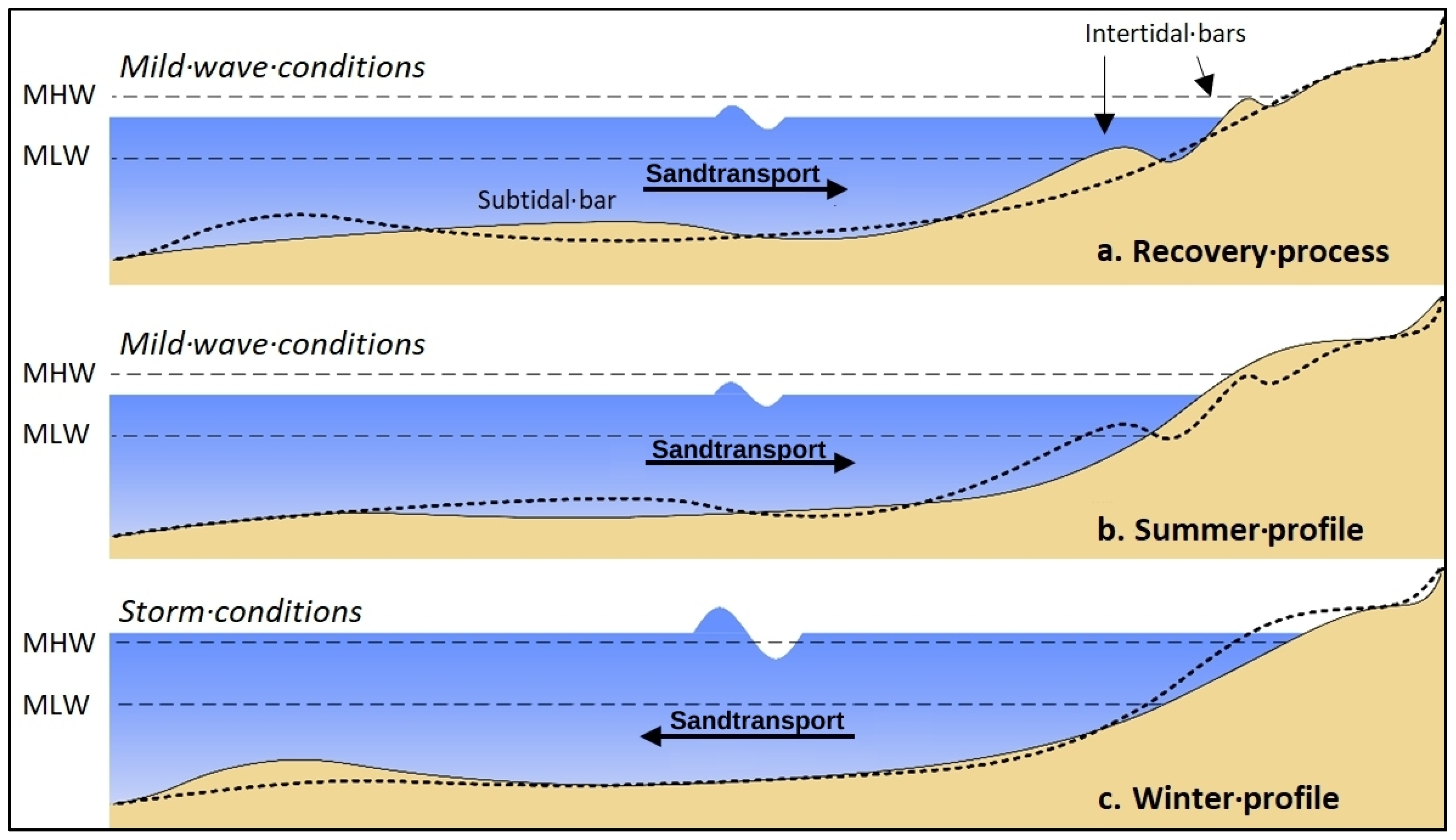
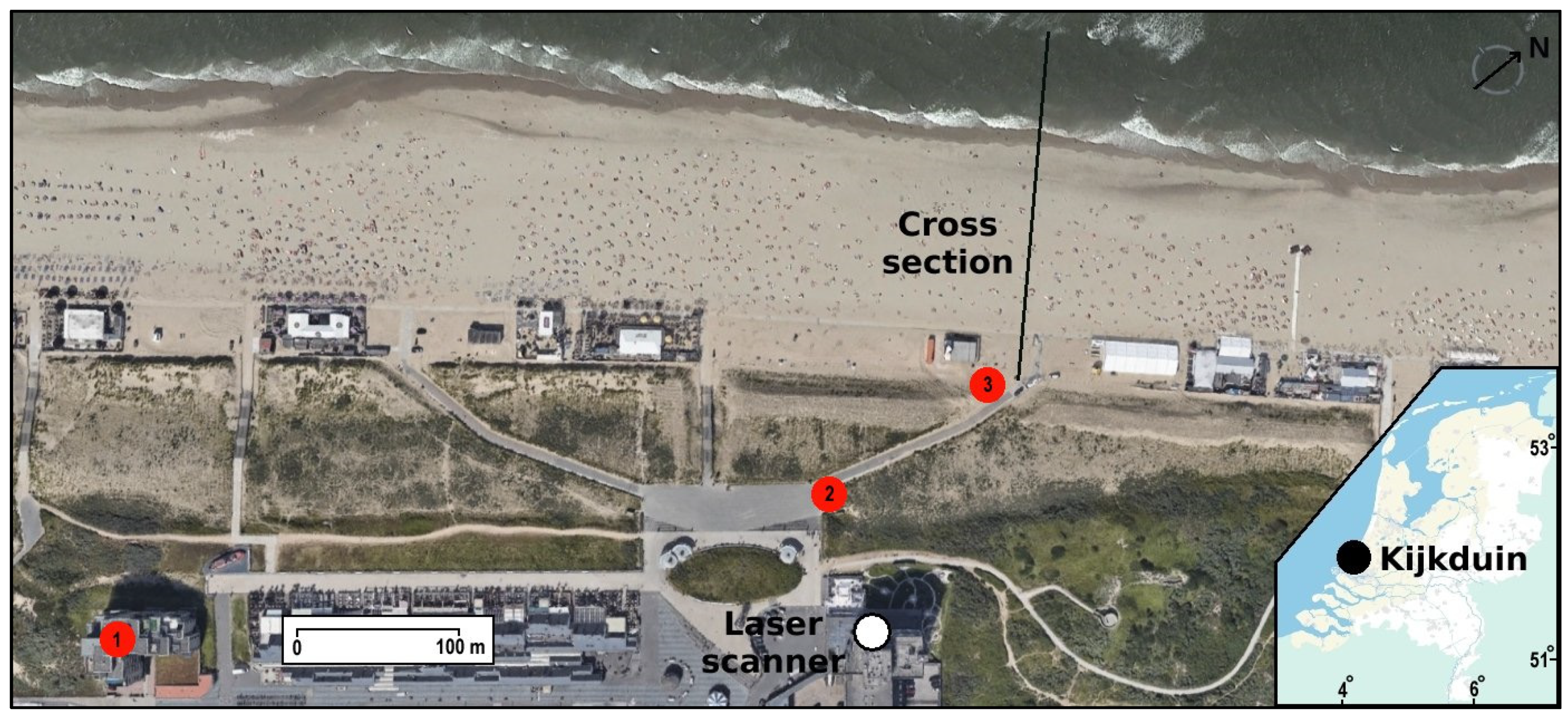
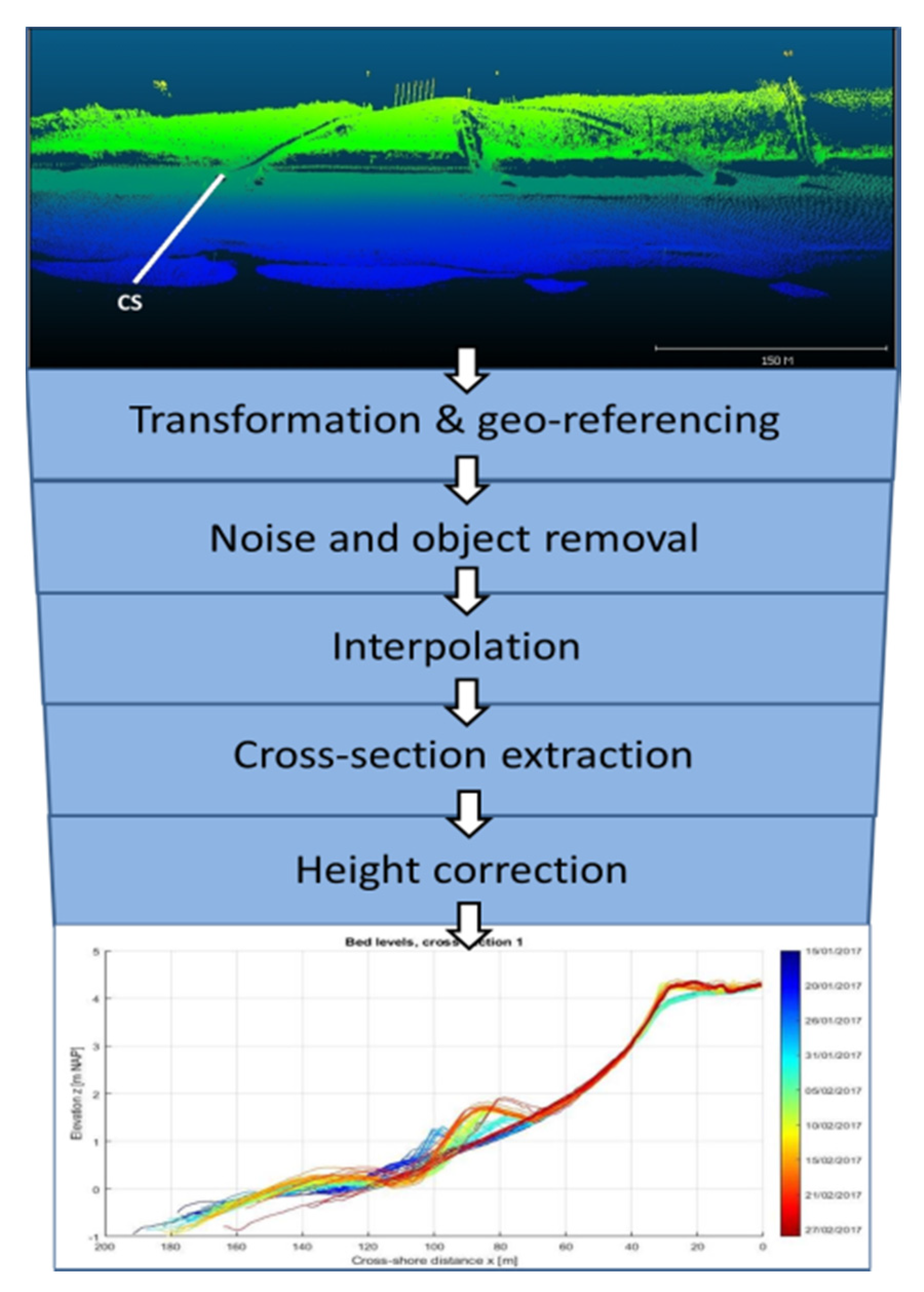
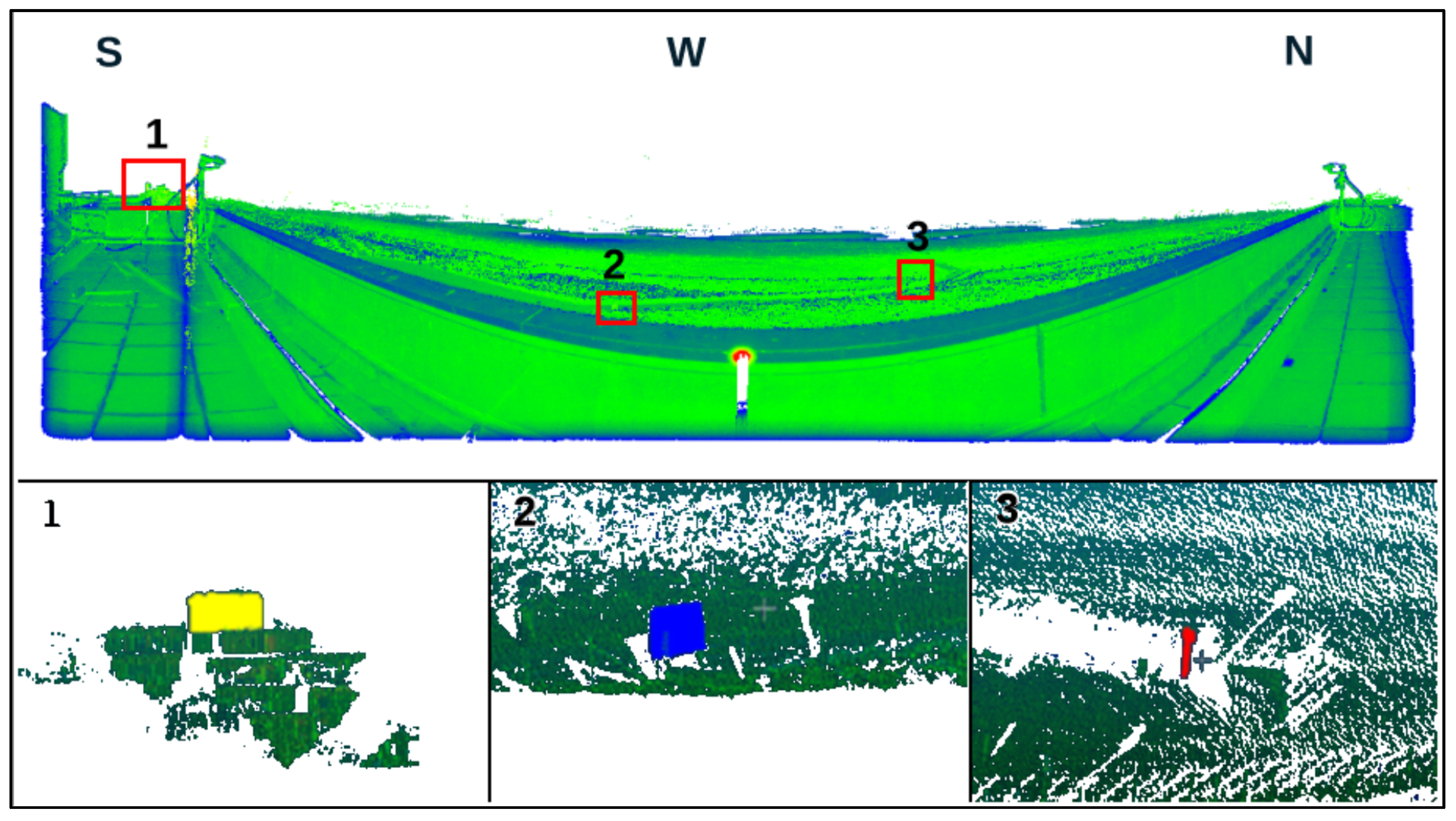
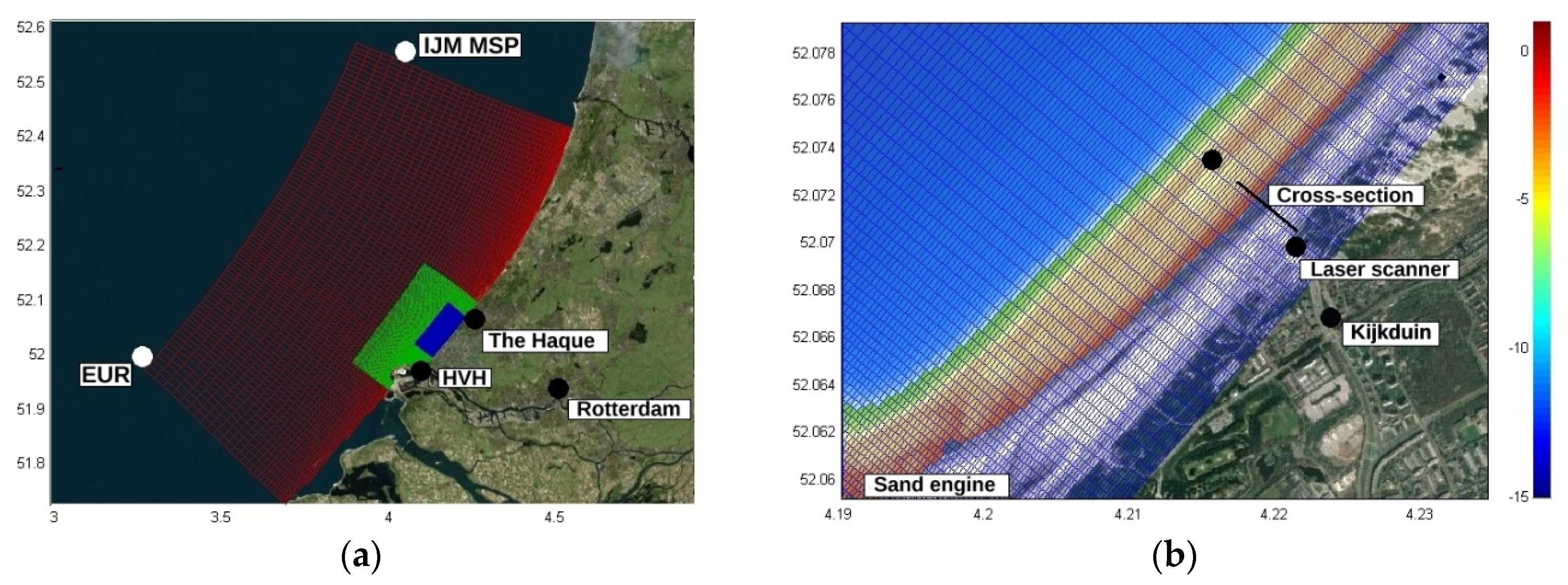
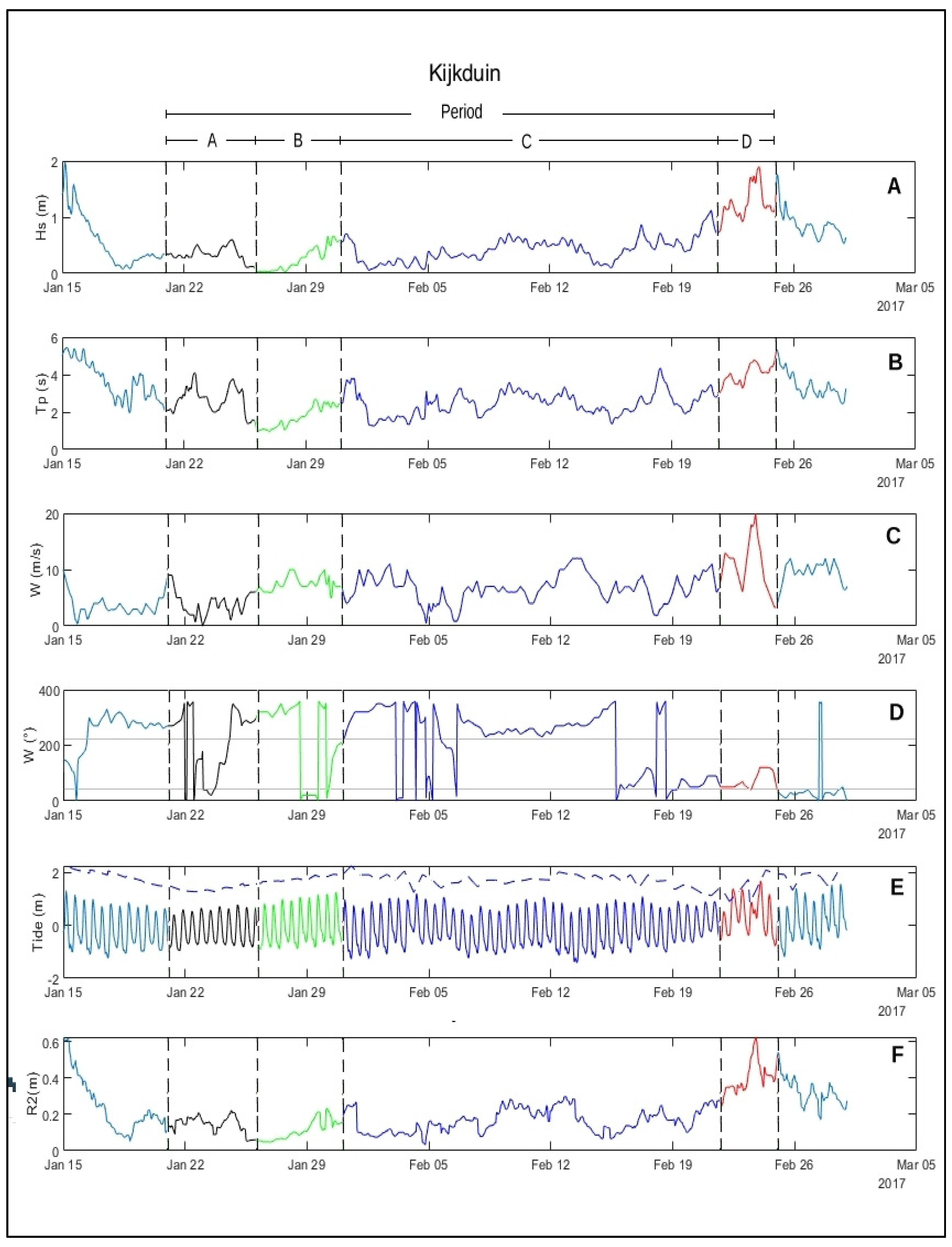
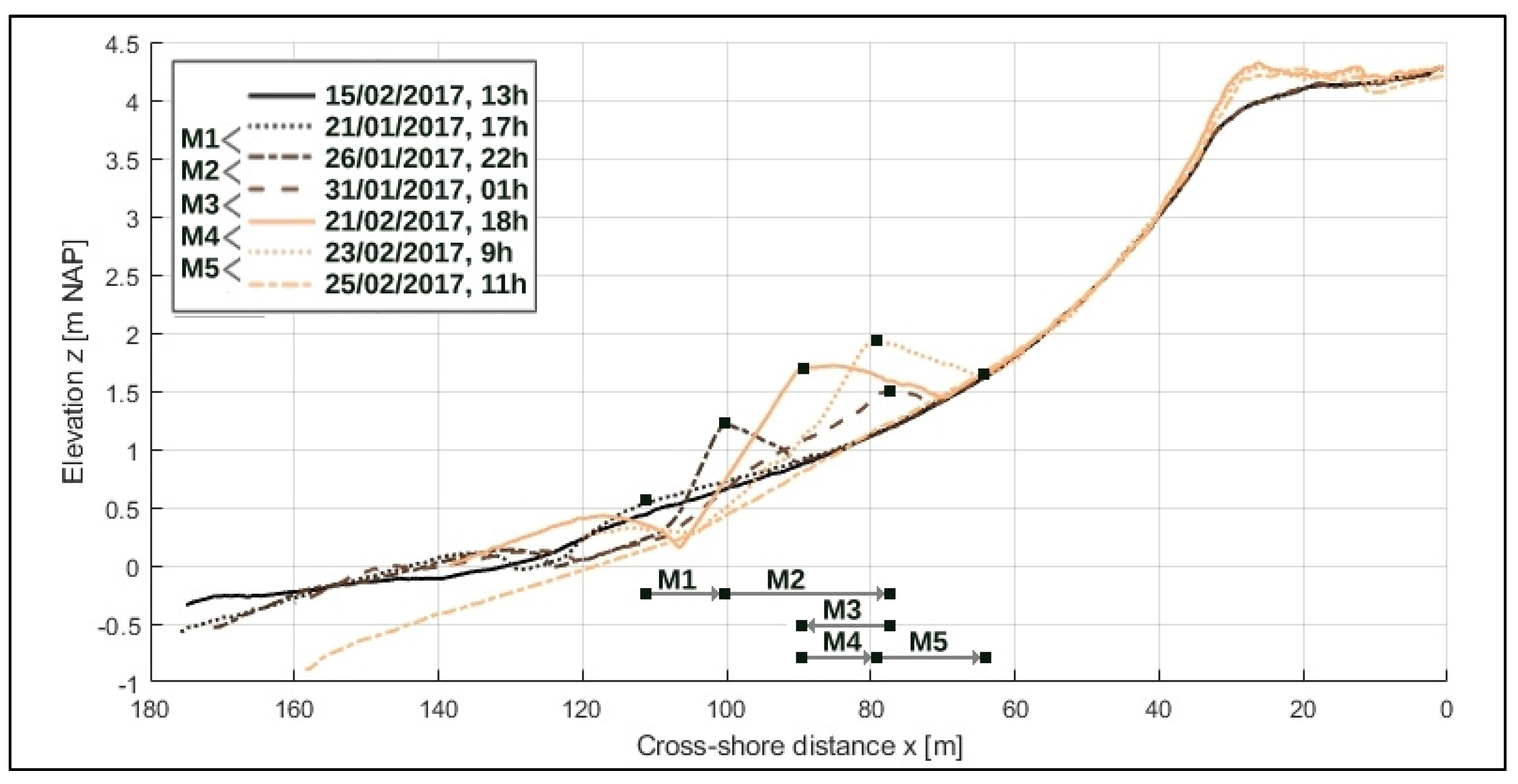
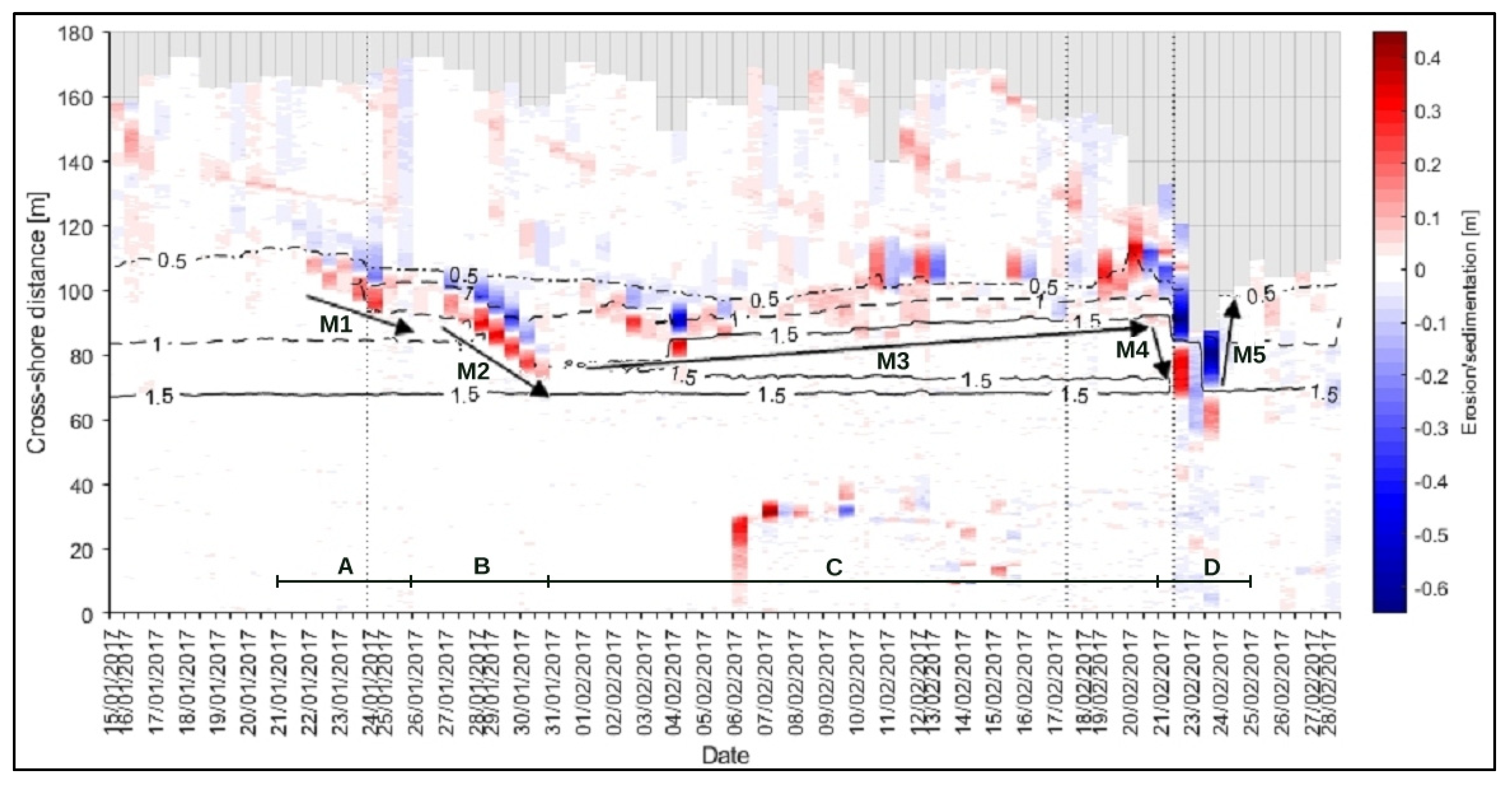
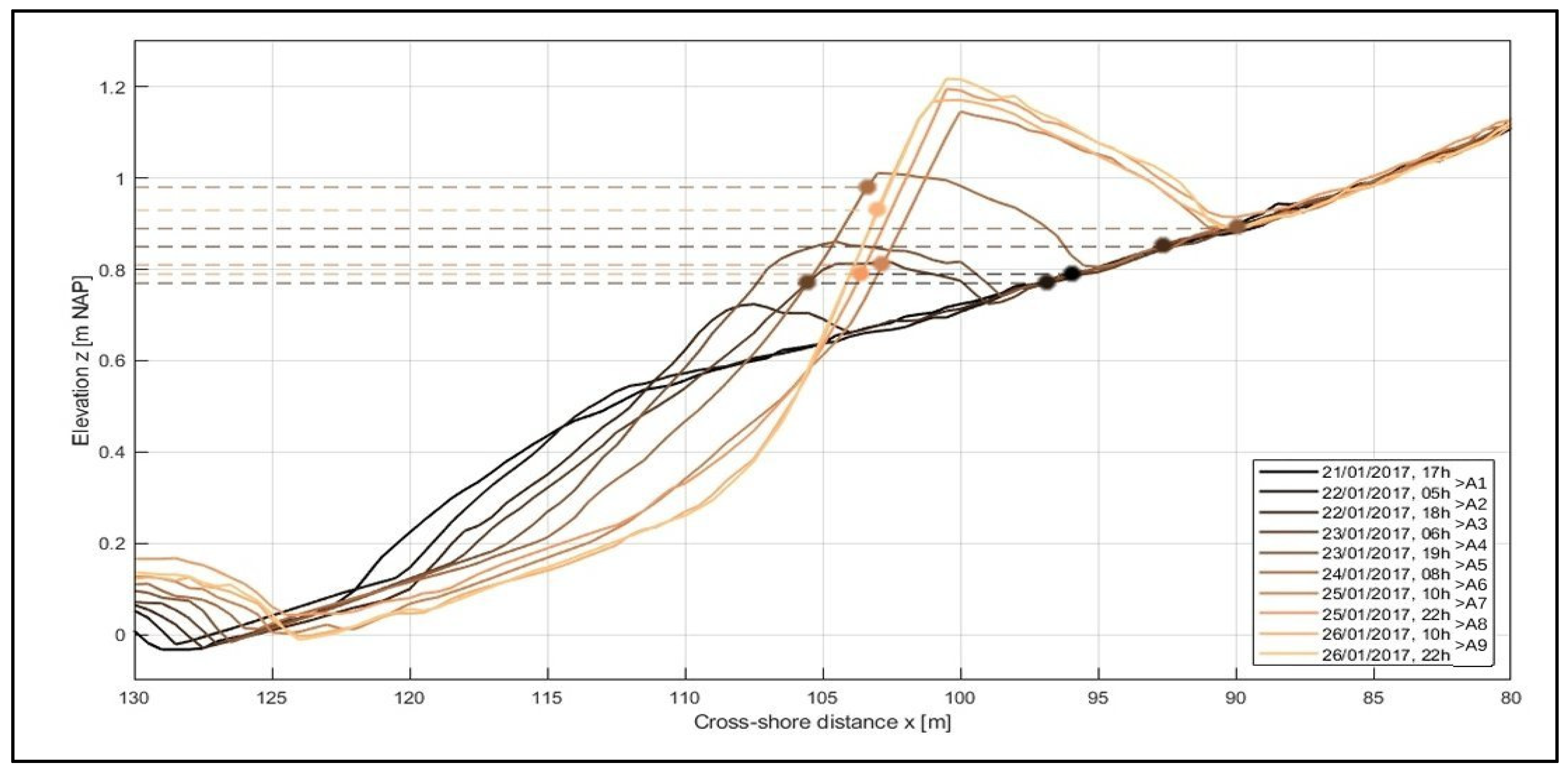
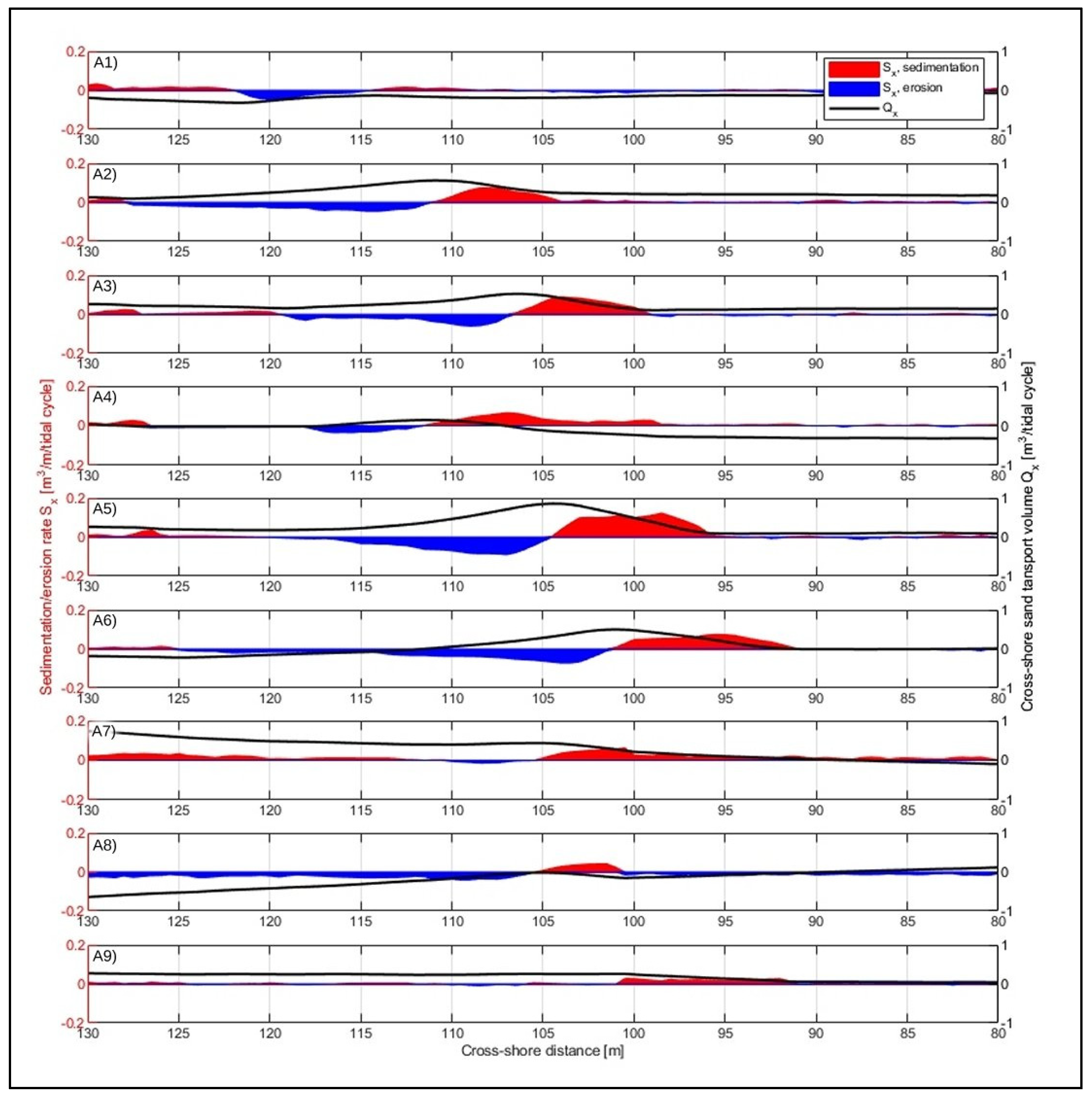
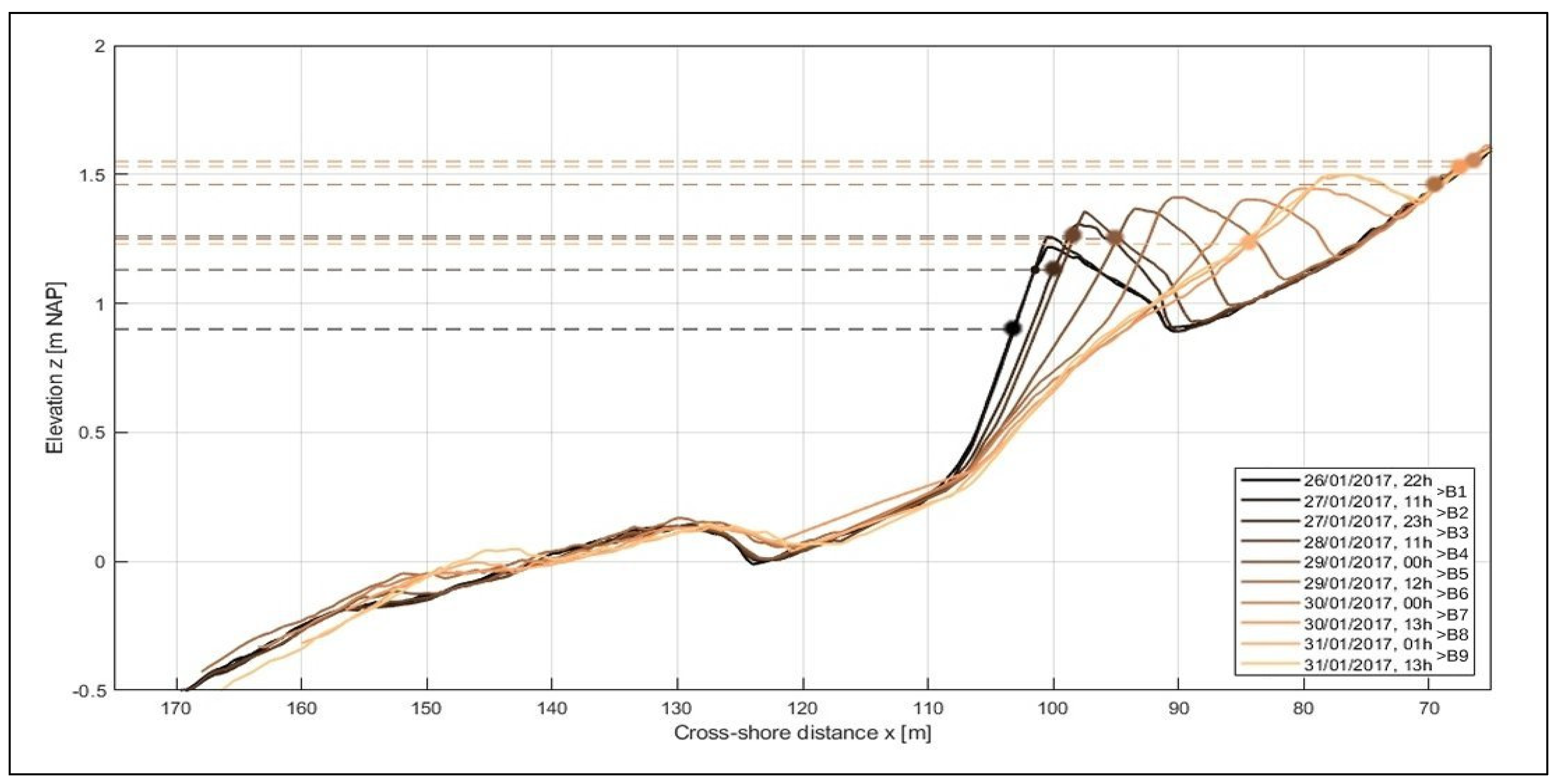
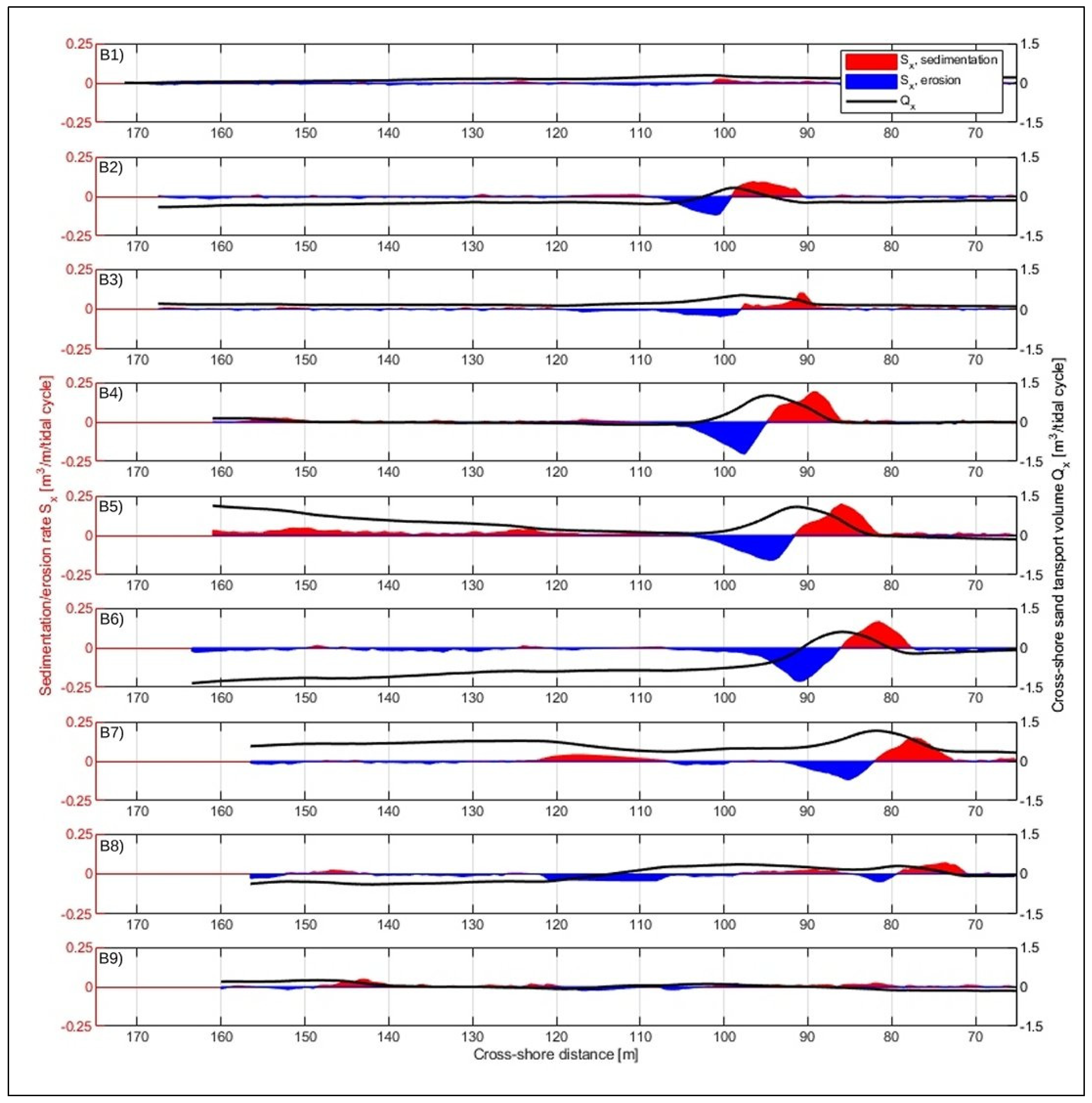
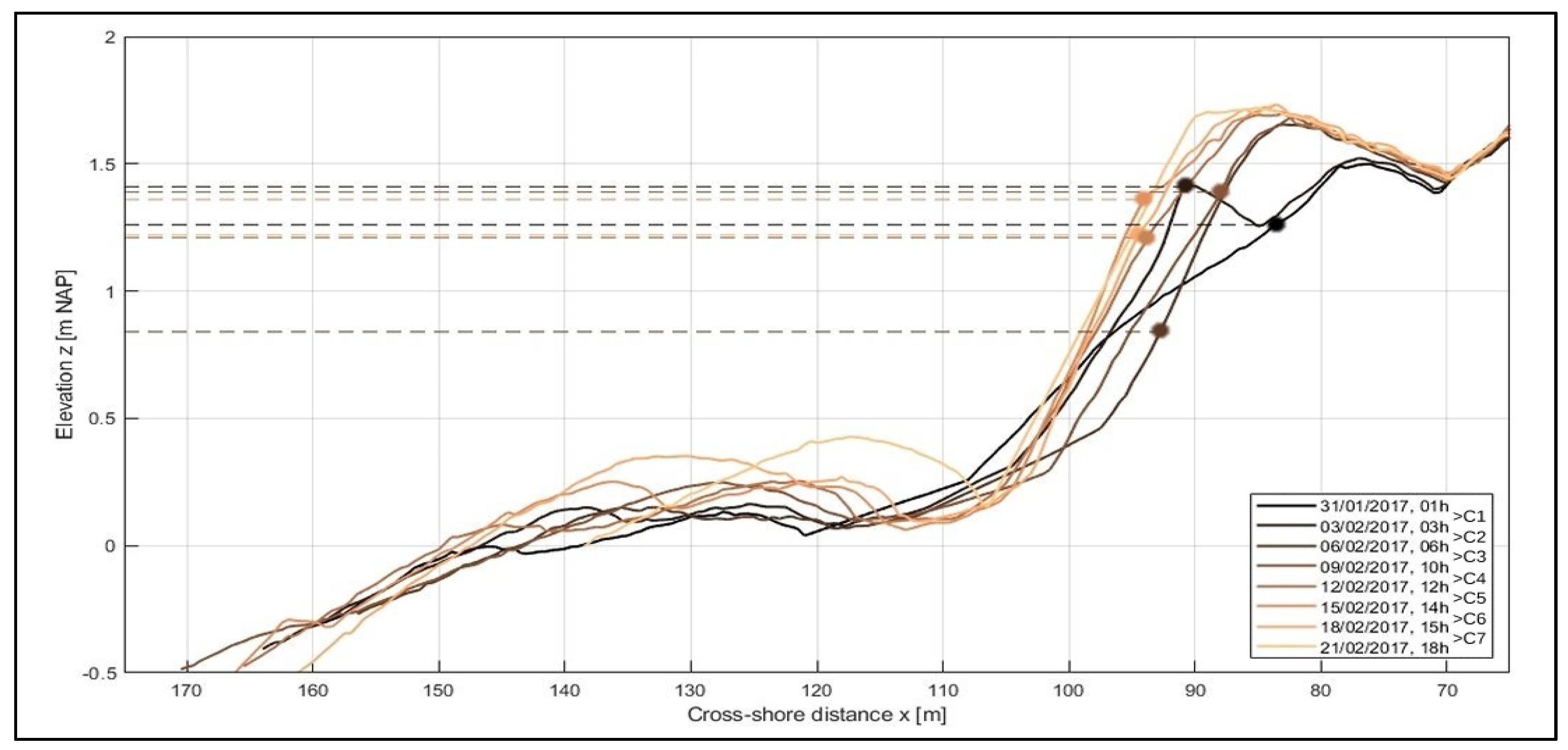
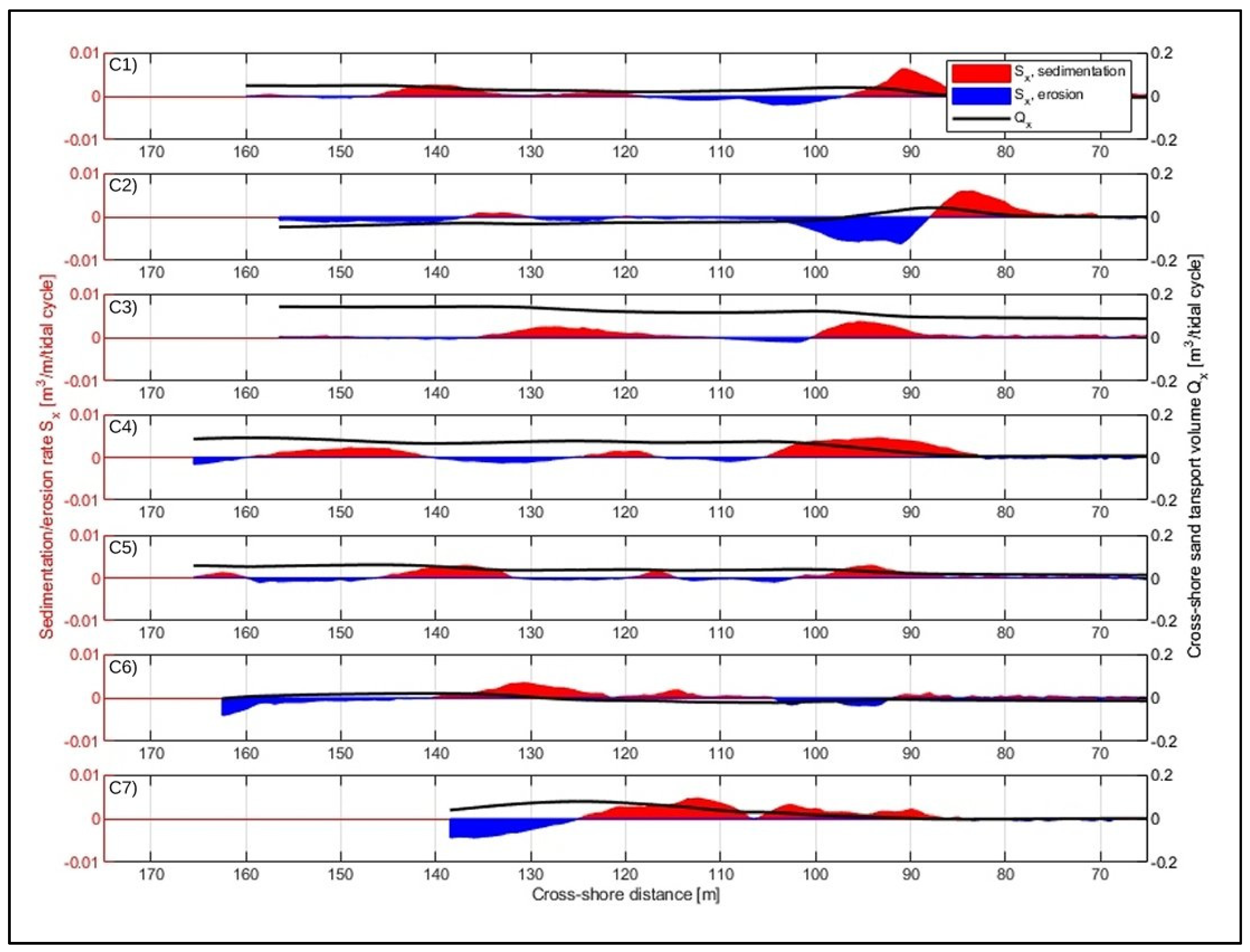
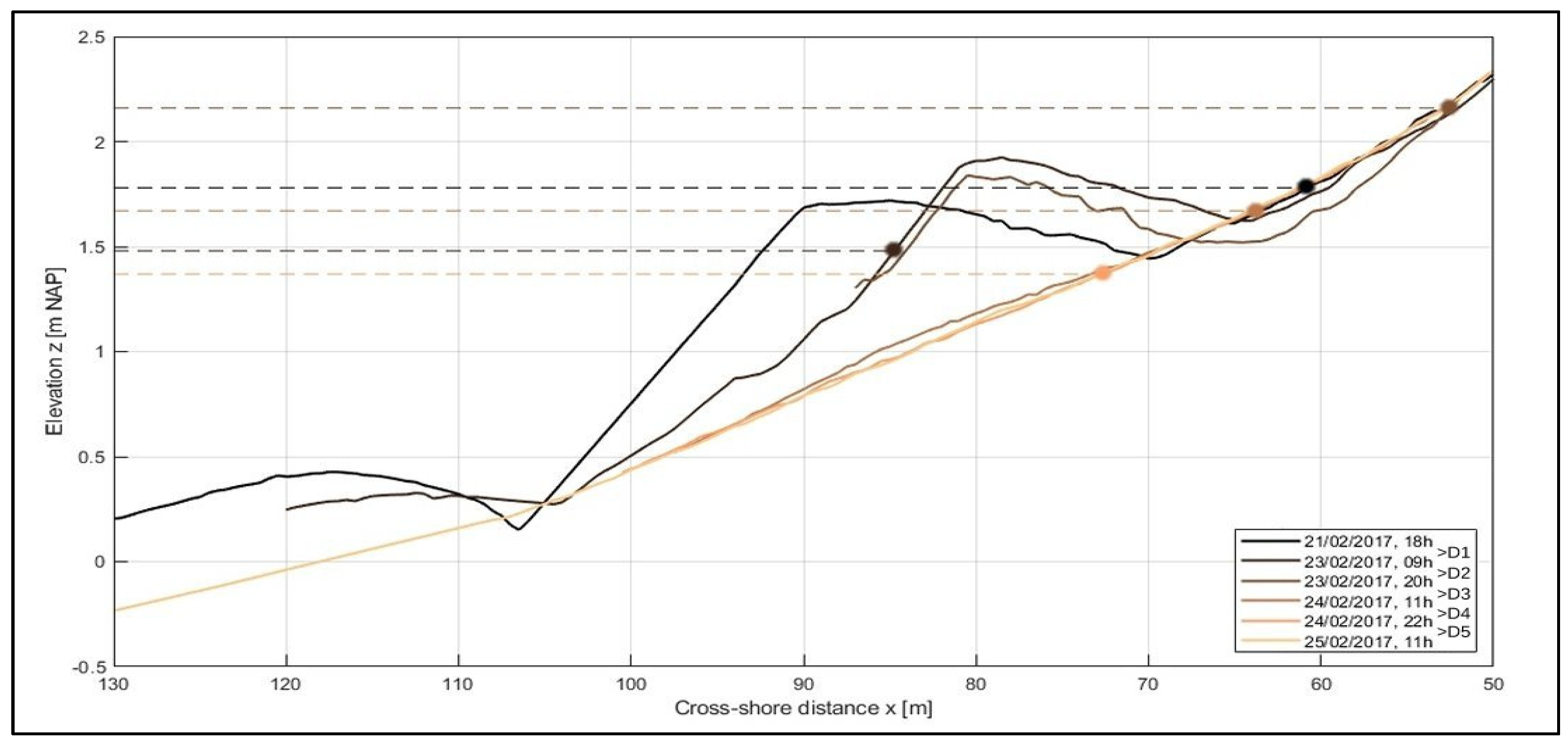
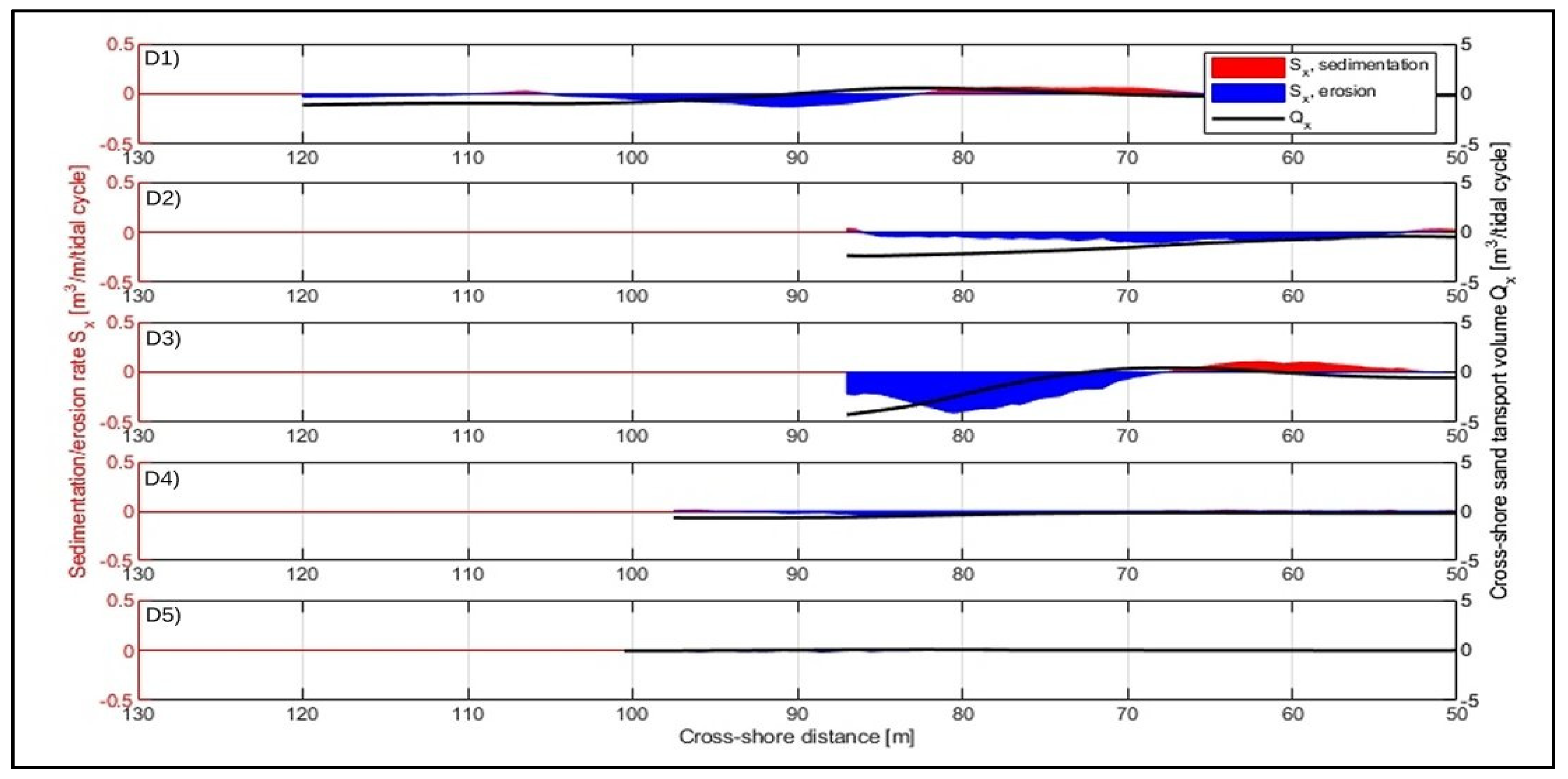
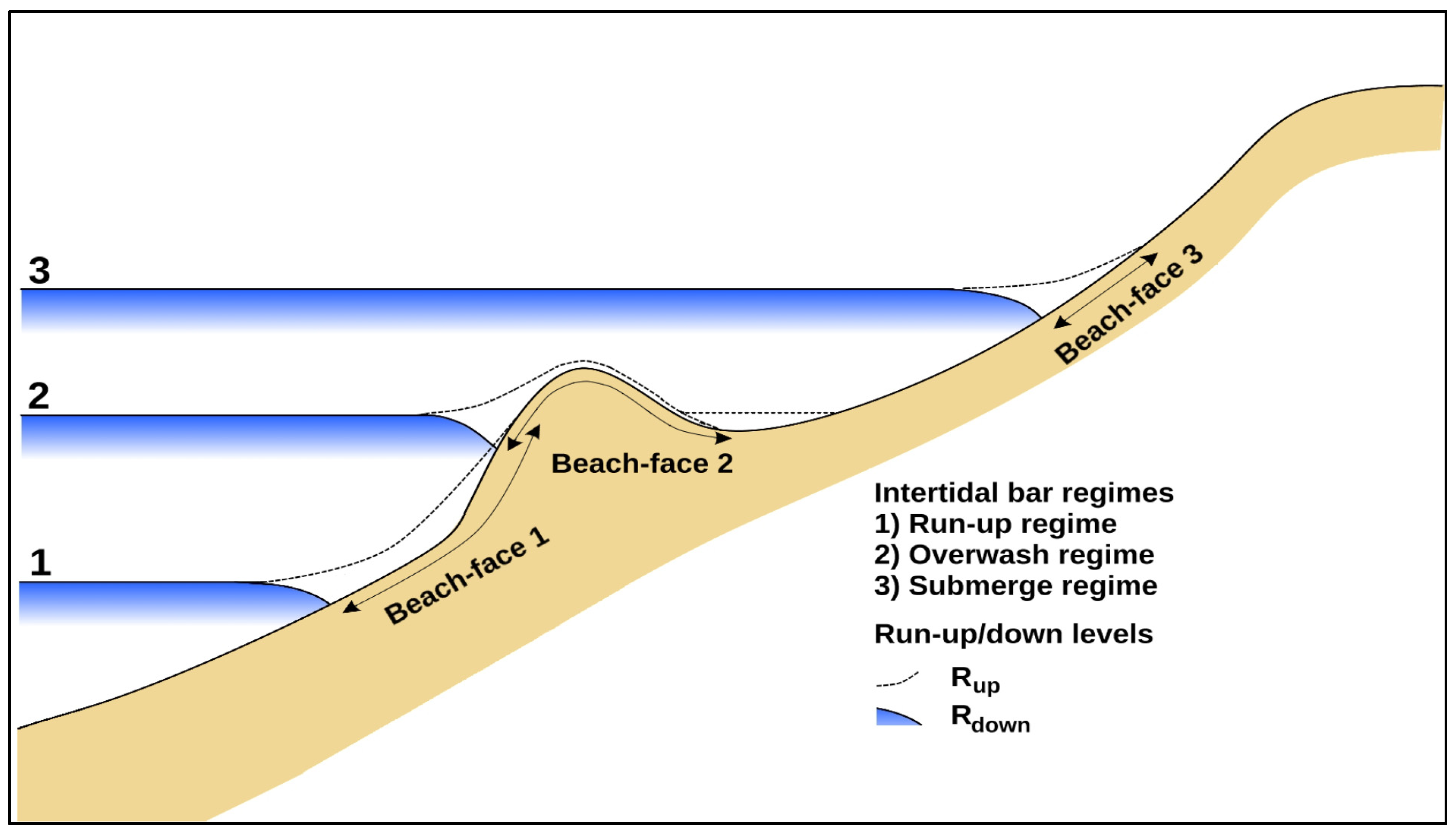
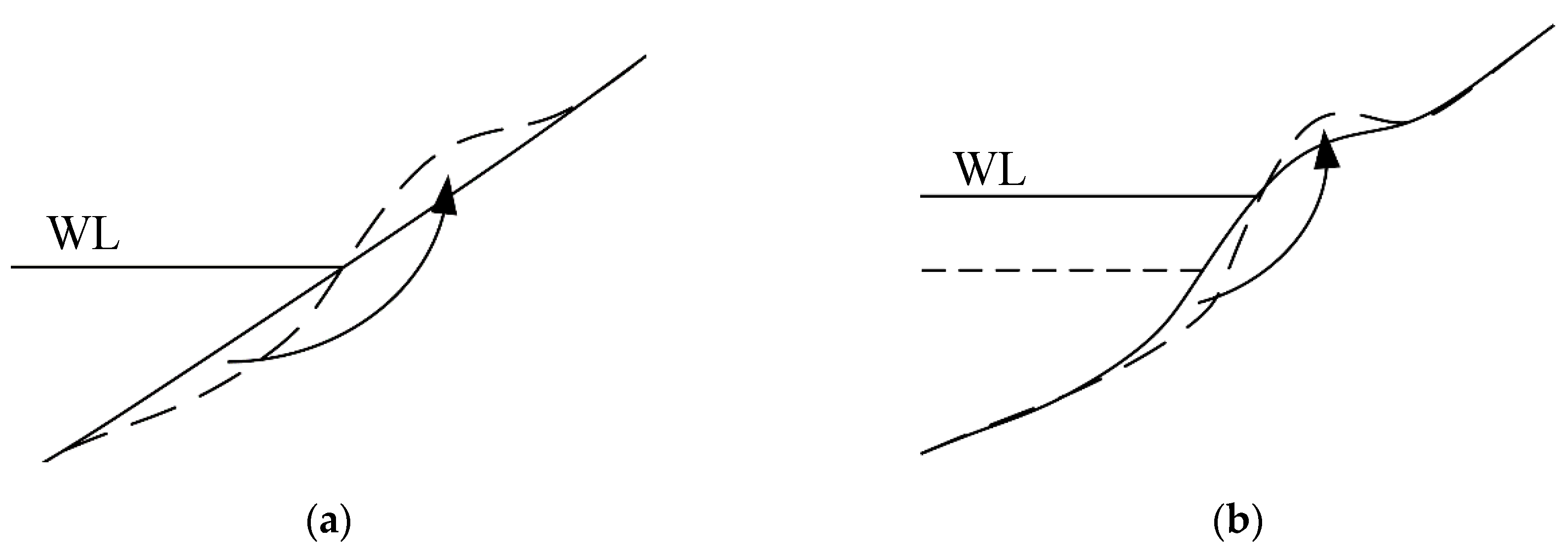
| Development Stage | A. Formation | B. Migration | C. Growth | D. Destruction | |
|---|---|---|---|---|---|
| Wave conditions | Mild | Mild | Mild | Energetic | |
 | 1 |  |  | ||
| Run-up regime | |||||
| Sand transport dominated | Formation, if:
| Horizontal growth | |||
| by swash zone processes | |||||
| 2 |  |  |  | ||
| Overwash regime | |||||
| Intertidal bar | (Fast) onshore migration | Horizontal+ vertical growth | Destruction | ||
| dominated by swash zone processes | |||||
| 3 |  | ||||
| Submersion regime | |||||
| Intertidal bar | (Fast) destruction | ||||
| dominated by surf zone processes | |||||
Publisher’s Note: MDPI stays neutral with regard to jurisdictional claims in published maps and institutional affiliations. |
© 2020 by the authors. Licensee MDPI, Basel, Switzerland. This article is an open access article distributed under the terms and conditions of the Creative Commons Attribution (CC BY) license (http://creativecommons.org/licenses/by/4.0/).
Share and Cite
Vos, S.; Spaans, L.; Reniers, A.; Holman, R.; Mccall, R.; de Vries, S. Cross-Shore Intertidal Bar Behavior along the Dutch Coast: Laser Measurements and Conceptual Model. J. Mar. Sci. Eng. 2020, 8, 864. https://doi.org/10.3390/jmse8110864
Vos S, Spaans L, Reniers A, Holman R, Mccall R, de Vries S. Cross-Shore Intertidal Bar Behavior along the Dutch Coast: Laser Measurements and Conceptual Model. Journal of Marine Science and Engineering. 2020; 8(11):864. https://doi.org/10.3390/jmse8110864
Chicago/Turabian StyleVos, Sander, Lennard Spaans, Ad Reniers, Rob Holman, Robert Mccall, and Sierd de Vries. 2020. "Cross-Shore Intertidal Bar Behavior along the Dutch Coast: Laser Measurements and Conceptual Model" Journal of Marine Science and Engineering 8, no. 11: 864. https://doi.org/10.3390/jmse8110864
APA StyleVos, S., Spaans, L., Reniers, A., Holman, R., Mccall, R., & de Vries, S. (2020). Cross-Shore Intertidal Bar Behavior along the Dutch Coast: Laser Measurements and Conceptual Model. Journal of Marine Science and Engineering, 8(11), 864. https://doi.org/10.3390/jmse8110864





